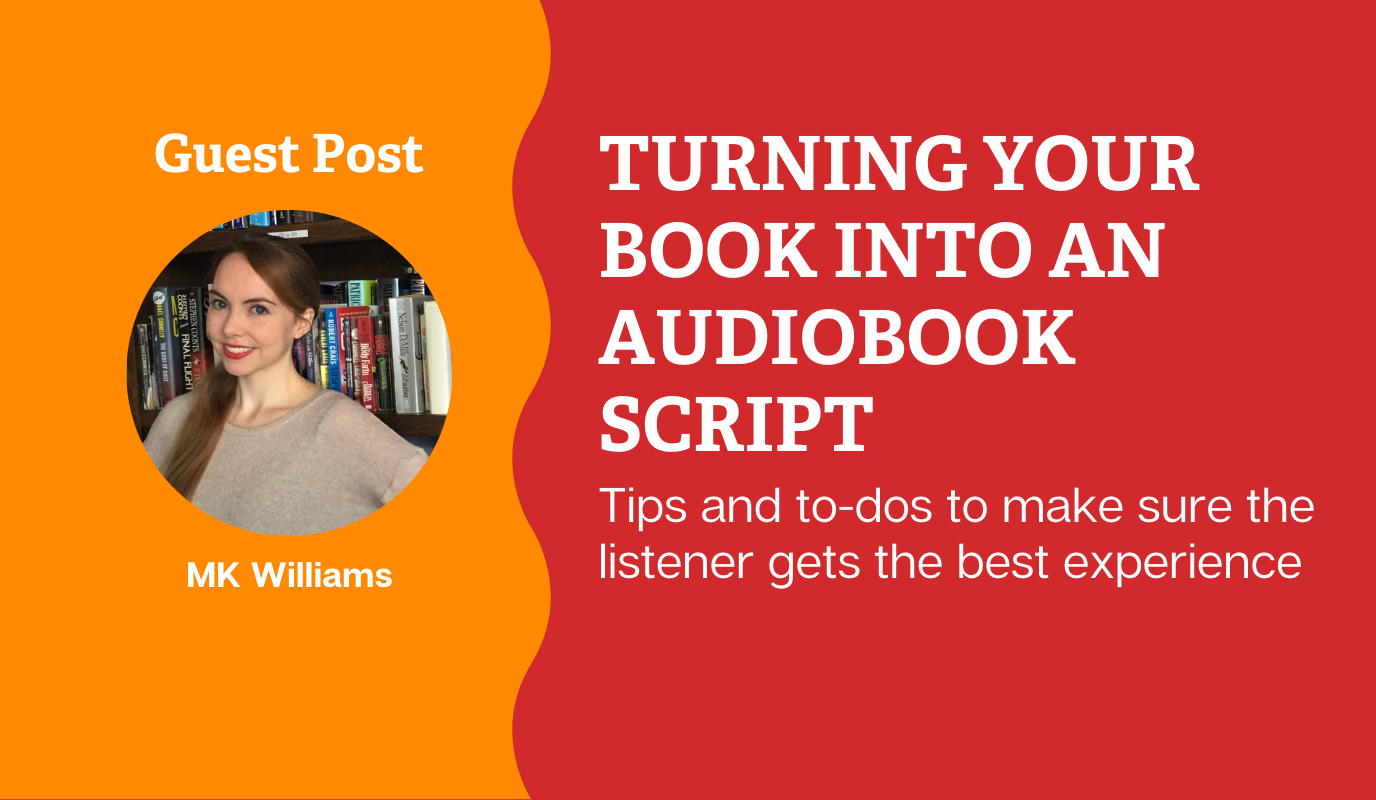Turning Your Book into an Audiobook Script
Tips and to-dos to make sure the listener gets the best experience

Tips and to-dos to make sure the listener gets the best experience
M.K. Williams is an author and self-publishing expert. She writes science fiction, suspense, and how-to guides for aspiring authors. After years of trial and error, she regularly shares her best tips and self-publishing advice on her website and youtube channel. Today she is sharing how to turn your finished book into an audiobook script:
You did it! What was once an idea in your mind is now a fully complete book. It’s printed and sitting on your bookshelf, available for sale on multiple retailers, and you’ve even signed a few copies. (Yes, autographing copies for your Aunt totally counts!)
But now, you have the daunting task in front of you of turning your words into audio. Self-published authors have been hearing the data for years now that audio is on the rise. Each year the percentage growth of audiobook sales continues to go up, and there isn’t a slow down in sight. Even with the pandemic last year, 50% of audiobook listeners said they made time to continue to listen to audiobooks even when their commutes to the office were cut. Audiobooks are not a passing trend, they are here to stay and as authors we need to meet reader and listener demands.
But is it really worth it to you to take on the additional time and effort to create an audiobook? Isn’t print and eBook enough? For you, maybe. But not for your potential audience. Your faithful print readers and eBook readers are different from potential audiobook listeners. And, while you may balk at the time and upfront cost of producing an audiobook, you could miss out on significant royalty opportunities if you don’t have one. Think of this as an investment in another stream of income for your book.
If you’re a series fiction author and you’re not producing audiobooks yet, what are you waiting for? In 2020, the Action & Adventure genre saw almost 500% growth in terms of listening audience, and the Science Fiction genre saw over 300% growth. Those aren’t typos, there is really that much demand for audiobooks.
Hooray, you’re sold and about to dive into the wonderful world of self-publishing your audiobook. Good thing you already have a script, it’s your book!
Not so fast.
The way you wrote that book was for a reading audience. And I don’t mean that they identify as readers or book nerds. No, you wrote it to be consumed with their eyes. Not their ears. There are distinctions between the two mediums (print and audio) that need to be taken into consideration before you record one second of audio. Whether you narrate the audiobook yourself or hire a professional to do so, you need to turn that manuscript into an audio script.
I have done a bit of both. Working with the pros was great and I found that I enjoy recording as well after narrating a few of my own books. After some trial and error, I have found that these are the best tips to help you succeed in this endeavor:
Read your manuscript aloud. Writing with audio in mind is easier said than done, especially if the muse is really talking, the words just flow. This is where you may be more likely to edit with audio in mind. This can be hard to do if you just had your print book release into the world yesterday. But if you found this article before publication, go back through the manuscript and read it out loud. This is part of my own self-editing process before I hit publish. Not only can it reveal commonly used words that appear too frequently, but it can help you pinpoint any typos that were otherwise missed. This technique also helps you to catch the items that just won’t fit into audio.
I find this often in the non-fiction world. An author will write out their content, then say, “as you can see in this chart,” and let the image do the work of drawing the conclusion for the reader. This is not good writing in the first place. Your job as the author is to write. If you are making a point then your words need to do the work, any graph or image should underscore or highlight what you had written. This becomes doubly important when you are thinking about how the book will translate to audio. If the narrator reads out, “as you can see in this chart. (pause) And now onto our next topic,” the listener will think the track skipped. They must have missed something.
Any visuals should have accurate titles and captions in terms of the data source as well. The caption can become the audio script for the description of the image, if it is still needed.
Keep in mind that any end of chapter activities or prompts will be read aloud. Any short links in your book to get more information should be easy to say as well as read. You can call out the short link, “go to www.website.com/extras to get your extras.” Link shorteners can make it easy for someone to retype but they will sound like garbled mush when read aloud. Best to create an intuitive short link that can be easily remembered.
While visuals and phrasing specific to charts and graphs are usually reserved for non-fiction, some of these issues can also arise in fiction. The sweeping 500 page saga with warring families that has an intricate family free at the beginning of the book, how can your audio audience access this kind of guide? Instead of reading out the genealogy of your characters, offer it as a digital extra and direct listeners to head to www.yourwebsite.com/familytree or something like that so they can reference this guide.
Keep notes and comments in the document. As you work through each draft highlight any areas that will not work in audio. This can be the graphs or images, or any of the following phrases. They can stay in for the print edition, but once you begin to work on the audio script these highlighted portions need to go:
- As you can see below
- As you read above
- As you will see on page X
- Read that again
- As we just read
- Above (works on blogs or digital documents)
- Below (works on blogs or digital documents)
You can do a simple search through the document to find any of these key phrases to help make sure you didn’t miss any. If you are doing the narrating you can always correct this on the fly. But if a professional is working with your audio script, you will need to have this taken care of for them.
Narrating numbers. If you thought writing math formulas was hard, just try reading them aloud. While you can’t make the subject matter more lively, you can make for a more pleasant listening experience for your audiobook readers. The key here is consistency. While math is the same in every language, the way we talk about numbers can have a lot of variation.
- In the text is ¾. Is that to be read “three fourths” or “three quarters?” Spell it out. Not just for a narrator, but for yourself. It takes a while to record and you may not remember how you pronounced fractions the day before.
- In the text is August 8, 2018. Is that “August eighth, twenty-eighteen” or “August eight, two-thousand eighteen” or “August eighth, two-thousand eighteen” or “August eight, twenty-eighteen?” See how much variation they can be for one date?
- In the text is n3 , is that read “n to the third power” or “n - cubed?” You get the idea.
These details matter because you need to be consistent throughout the book. To do this do a search of the document (CTRL+F) for each integrer (0, 1, 2, 3, etc.) and review the sentences. Rewrite them as needed to ensure the way these are read out will be consistent.
Pronunciation guide. This is especially important if you are outsourcing the narration to a pro. Don’t ever assume that someone will know how to pronounce names, places, and niche terms the way that you would. Let’s take a look at one example in non-fiction, one in fiction, and the best solution for either scenario:
- Non-fiction: Let’s say your personal finance book has a chapter on retirement savings. You will likely mention an IRA (Individual Retirement Account). Some in the finance industry enunciate each letter of the acronym I.R.A, while others pronounce the word phonetically, as though Ira was a person. Neither option is wrong, it is a personal preference for the author on how it should be pronounced.
- Fiction: This should probably go without saying, but no one else will know how to pronounce the words, names, planets, and gorgons in your fantasy saga, especially when they are in the made-up language you constructed for that book.
- In either case you have two options for offering pronunciation guides to your narrator. One is to do this in-line with a bold and highlighted note next to the word. “Niche” (pronounced like “itch”). Or you can do a short recording with the phonetics. This is helpful to you as a narrator as well. If one of your characters has an accent, they will pronounce a given word differently from the rest of the cast. No one else will hear this audio clip, so don’t worry about perfection. Even if you are camera/audio-shy, these details can make or break the success of your audiobook.
Yes, this is a lot of extra work to do, but you didn’t just spend how many months (or years) perfecting your manuscript to rush the audiobook production. And since no one knows your book better than you, it is best if you take these steps to ensure it will sound the way you imagined.
Seeing the growth in audiobook sales will get you excited to jump in, but looking at the work to be done and the time to produce an audiobook can feel intimidating. Don’t stress. There are so many great resources out there for self-publishing authors to be able to produce a quality audiobook. Findaway Voices makes it easy to get your book uploaded and out to retailers so that once your audiobook script has been turned into beautiful audio files you can get it out to your waiting fans quickly. Sign up with Findaway Voices today and get to work on creating and selling your audiobook!

